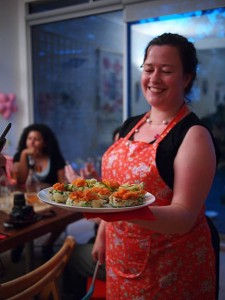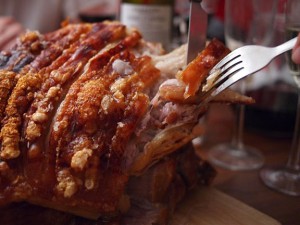
My friend Niamh, who blogs at Eat Like a Girl, has just published Comfort and Spice: a beautiful recipe book, densely packed with recipes. (Important, this. Have you noticed how a lot of recent cookery books have a lot of pictures, very big text and surprisingly few recipes? Not this one.) If you’ve been following UK food blogs at all over the last few years, you’ve probably come across Eat Like a Girl. It’s one of my favourite UK cookery blogs: Niamh’s writing voice is just like her conversation, wry and full of energy; her photography is jealousy-inducing; and her recipes are, it goes without saying, bleedin’ marvellous.
Comfort and Spice, the new book in question, is the result of a year’s hard slog, and it’s full of new recipes which don’t appear on Niamh’s blog. The comfort’s all in the home-made butter, pork crackling, parma ham-flavoured salt and parmesan bone marrow that fills the book; the spice brings warmth and depth to the recipes – rose petals, cinnamon, lemongrass, Szechuan peppercorns and bay leaves in a flurry of international recipes.
The book is divided into smart chapters, which you’ll actually find useful in the kitchen. Quick suppers are always a useful resource, but best for me is the section on eight great big dinners – with pointers to what to do with the leftovers.

Niamh invited Dr W and me round for dinner with some other friends to try some bits from the book, and some recipes which didn’t make it in. All fantastic – bacon-infused vodka (not in the book – I hope the recipe turns up in a book or online soon) sounds mad, but made a simply superb bloody mary. Overnight-cooked pork shoulder with a spiced apple relish is pure Niamh: packed with flavour, trimmed with lovely bits of crackling, and sauced with real gusto. Irish potato pancakes with smoked salmon and cucumber relish are in the book, and I was quickly face-down in them, only to be diverted by something called bacon jam with the book’s blaas (one of the few yeasted Irish breads).
Now, if you’re not familiar with Niamh’s cooking, I can’t think of a better place to start than with the bacon jam, which is like a meaty version of crack. Seriously. Once you start eating it, it is basically impossible to stop; a very unattractive look, especially if there are eight other people trying to get to the bowl. It’s on her blog already, so didn’t appear in the book, and she’s given me permission to reproduce the recipe here. Go and cook it, and make sure that you’re alone when you eat it, because bacon jam smeared all over a salivating face is not attractive. Then go and buy the book to induce some more salivating.
You’ll need:

500g streaky bacon (it has to be streaky), chopped into small dice
4 cloves garlic, finely chopped
1 red onion, finely diced
50g brown sugar
50mls maple syrup
50ml cider vinegar
1 tbsp red wine vinegar
250ml fresh brewed coffee (NOT instant – important)
2 chipotles in adobo (2 chillies – NOT 2 tins!), finely chopped
Sauté the bacon over a medium heat until starting to crisp.
Take the bacon out and fry the onion in the bacon fat until softening but not coloured. Add the garlic for about a minute.
Transfer the bacon, onion, garlic to a large pot with the rest of the ingredients (excluding the red wine vinegar). Simmer gently for one hour, adding a little water every 30 minutes if required (I only had to do this towards the end). Add the red wine vinegar in the last 5 minutes.
You can pulse the jam in a food processor briefly (to retain the course texture) although I felt it didn’t need it as the bacon was chopped quite small.
Ready to serve. Will keep in the fridge too although I doubt you will have any leftover.
